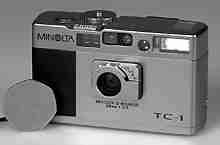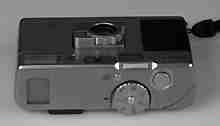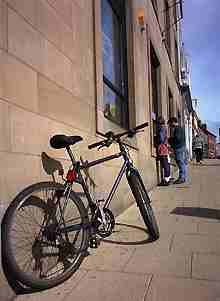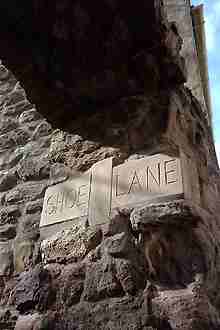The Minolta TC-1
The Minolta TC-1 is the smallest 35mm AF compact ever made. With a titanium
body and very original design, it is also one of the best looking 'status
symbol' models yet. The TC-1 makes no attempt to be a retro camera, whatever
others may say; it simply re-interprets a mixture of electronic and mechanical
controls neatly. First impressions are deceptive. It seems far too small
to be practical; the on button is a tiny circle near the eyepiece, the spot
metering button an even smaller one, and the main selector control a push-slide
switch. The lens, when it emerges, has an odd crest which moves to set the
fixed Waterhouse stop apertures of 3.5 (maximum of the 28mm lens), 5.6,
8 and 16.


Even loading the camera is frightening p; a huge expanse of inner glass
element is just a millimetre or so from the film when the camera is collapsed
shut, with a bit of flocked origami light baffling folded against it. For
this reason I would advise always loading the camera is ON and open mode.
However, it loads smoothly and perfectly. The buttons are proud to exactly
the right amount to respond to blunt finger pressure. The big function dial
and clear LCD display, combined with the selector switch to cycle through
possible settings, work unambiguously and clearly. That's a good thing as
our sample had no instruction book. Everything worked. DX coding functioned
even with the Ektar 25 colour negative film I loaded to test the lens quality;
the viewfinder proved extremely clear, with a good shutter speed readout.
After half an hour, the tiny camera became a natural extension. It was just
so easy to take pictures well with it p; it has all the things I like
about the Minox 35 and the Contax T2, plus a 28mm lens and absolutely positive
AF and exposure control.

The viewfinder brightline frame touched the apex of the roof and the
extreme corners or edges of the buildings, showing that the film actually
records a little more than you think.
The results were great. The lens is geometrically impeccable and very sharp.
Its only flaw is a degree of light fall off to the edges, which is not reduced
by stopping down to 16. Personally I don't object to this hot spot of around
2/3rds of a stop, graded in to the centre of the image. The most remarkable
aspect of this lens is its freedom from flare.

You can shoot right into the sun (above) and not a trace of any ghost or
internal reflection pattern will appear. You even get shadow detail. Colour
was bright and clean, and the overall 'feel' of the negatives equal to the
best SLR. The TC-1 has slow-synch flash, red eye prevention, self-timer,
exposure over-ride and all the functions we expect from a current AF compact.

It also has a finish to rival Contax, Rollei, Minox and Leica and a price
tag of around £1,100. It is very usable for estate agent, building
progress, travel and general record photography but the 28mm lens is not
ideal for portraits, children or pets p; yes, I did try, and I didn't
much like lying on the floor to avoid gnome-like overhead views. This is
a totally professional camera though aimed squarely at the affluent, internationally
mobile amateur. As a long-time Minolta user I am delighted to see the name
on this particular product.

A panoramic shot taken from the top of a frame shows good geometry and
illumination.


Above left: great depth of field given by manual control, shooting at
f16 with Kodak Ektar 25 film, focused on the bike handlebards and sharp
from the rear wheel to infinity. Right: accurate close framing and focusing,
and very accurate exposure, recording an alleyway name plaque in Berwick
on Tweed
Return to June 1996 Contents









